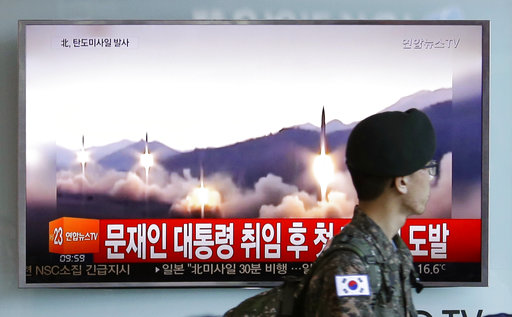North Korea says latest missile launch was new type of rocket

A South Korean army soldier walks by a TV news program showing a file image of missiles being test-launched by North Korea, at the Seoul Railway Station in Seoul, South Korea, Sunday, May 14, 2017. North Korea on Sunday test-launched a ballistic missile that landed in the Sea of Japan, the South Korean, Japanese and U.S. militaries said. The launch is a direct challenge to the new South Korean president elected four days ago and comes as U.S., Japanese and European navies gather for joint war games in the Pacific. The signs read: “The first provocation since the inauguration of President Moon Jae-in.” AP
SEOUL—North Korea’s latest missile launch was a successful test of a new type of rocket, Pyongyang’s state media reported Monday.
Sunday’s launch was of a “newly-developed mid/long-range strategic ballistic rocket, Hwasong-12”, the official KCNA news agency said, adding that leader Kim Jong-Un “personally oversaw the test-launch of the new type of rocket”.
The isolated North is under multiple sets of United Nations sanctions over its nuclear and missile programs, which have set alarm bells ringing around the region and in Washington.
The North says it needs atomic weapons to defend itself against the threat of invasion and is widely believed to be making progress in its quest to develop a missile capable of delivering a nuclear warhead to the continental United States — something President Donald Trump has vowed “won’t happen”.
READ: N. Korea tests missile; US eyes tougher action
Article continues after this advertisementTensions between the two reached new heights in recent weeks, with Washington saying military action was an option being considered and Pyongyang issuing threats of its own, sending fears of conflict spiraling.
Article continues after this advertisementTrump later appeared to hold open the door to negotiations, saying he would be “honored” to meet Kim and called him a “smart cookie”.
Last week the South also elected a new president, Moon Jae-In, who advocates reconciliation with Pyongyang and said at his inauguration that he was willing “in the right circumstances” to visit the North to ease tensions.
But he slammed the missile test as a “reckless provocation” after holding an emergency meeting with national security advisers.
Dialogue would be possible “only if the North changes its attitude”, he said according to his spokesman.
KCNA said Sunday’s test was intended to examine the “technical details and characteristics” of a new type of rocket “capable of carrying a powerful and big nuclear warhead”, and also confirmed “the reliability of the newly-developed rocket engine”.
The missile followed its preset flight path to reach an altitude of 2,111.5 kilometers and travelled 787 kilometers, coming down at the “precise location intended”, it added.
‘Flagrant menace’
Since the beginning of last year the North has carried out two atomic tests and dozens of missile launches as it seeks to refine its weapons.
In April it put dozens of missiles on show at a giant military parade through the streets of Pyongyang.
The United States called for tougher sanctions against the North after Sunday’s missile test, with the White House saying: “Let this latest provocation serve as a call for all nations to implement far stronger sanctions against North Korea.”
The North “has been a flagrant menace for far too long”, it added in a statement.
The missile came down in the Sea of Japan (East Sea), with Washington saying it impacted “so close to Russian soil … the president cannot imagine that Russia is pleased”.
Russia’s defense ministry later said the missile landed about 500 kilometers from its territory and posed no threat.
The United States and Japan called for an emergency meeting of the United Nations Security Council, and a meeting has been scheduled for Tuesday afternoon, according to the UN mission of Uruguay, which currently holds the council’s presidency.
China, Pyongyang’s sole major ally and main trading partner, which has been under growing US pressure to help rein in its wayward neighbor, urged restraint.
“All relevant parties should exercise restraint and refrain from further aggravating tensions in the region,” said Beijing’s foreign ministry.
But KCNA reported Monday that Kim “told the rocket scientists and technicians not to be complacent… and continue to build more… nuclear weapons and methods of delivery” until the US made the “right choice”.
The leader also “warned that the US will not be able to avoid the worst-ever catastrophe if it recklessly provokes our republic”, it said, using standard language, and claimed that “all US mainland and US-Pacific regions are within the range of our attacks”.
Analysts believe that the North does not yet have this capability. But it described another launch earlier this year as a drill for an attack on US bases in Japan.